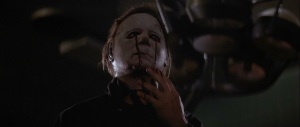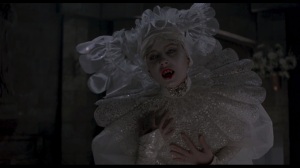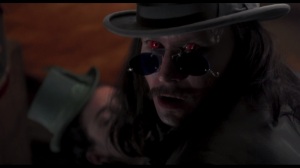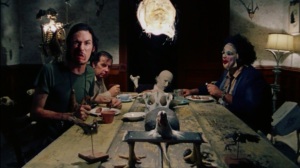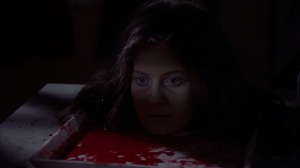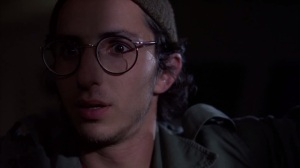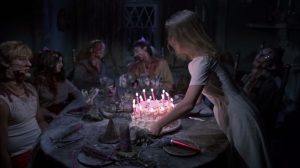







Bare Hands
Reviewed by: Pontifex Aureus
Home is your sanctuary. It’s the place where you sleep and the place you count on for privacy; home is sacred. Which is why the thought of some unearthly, malevolent presence invading that most personal of all spaces is so especially appalling. That is what makes the haunted house genre so effective at conjuring chills; it threatens us with the idea that our home is not safe—the idea that danger is living right alongside you in your most vulnerable moments. It is a fear that most of us have probably had, lying awake at night, listening to the house creak. It is this fear that The Changeling expertly preys on, using shadow and sound to stoke our imaginations, filling our minds with morbid fancies.
John Russell is a successful composer still coming to terms with the recent loss of his family. Seeking a new job in a new town, he takes up residence in a long-deserted, but stately manor house. However, he soon begins to notice strange sounds and inexplicable phenomenon in the house. These ominous signs seem to point him toward some dark, long-forgotten secret, and as he is pulled deeper into the mystery, Russell draws ever closer to danger from powerful foes both dead and living.


Like any good haunted house movie, the house itself is as much a character as any of the people, exuding an aura of menace throughout the film. The house is so compelling in fact, that it is hard to believe that it’s nothing more than an elaborately constructed set; the richness of its detail and design will have you utterly convinced of its realness. That’s important because the look of the house contributes greatly to the atmosphere of the film, with its many widely-framed shots, The Changeling puts the house on center stage, often dominating more screen-space than the human characters. Using only shadow, sound, and sly camera work, the house is given terrifying life. Point-of-view and over-the-shoulder shots are used to make it feel as if some unseen terror is about to pop out onto the screen, but then nothing does—a lesser film would take those opportunities to shock you with a cheap jump-scare, but The Changeling forsakes shock in favor of dread, teasing you with the possibility that something could happen. This is classic, slow-build horror craftsmanship, meant to be savored like a fine hand-rolled cigar.

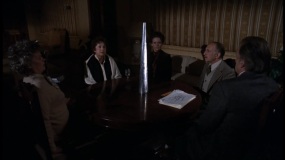
Aside from this carefully calculated atmosphere of impending doom, there is also a real gem of a mystery to be found here. Perhaps even more than it chills us, the film intrigues us, pulling us deeper into its secrets. This mixture of haunted house and detective story is interesting—the mystery adds to the horror by playing on our fear of the unknown, inviting us to make ghastly speculations before the puzzle is at last solved. If I have one complaint it is that, in my opinion, it would have been far more terrifying to not solve the mystery. To pull the audience in, tormenting us with clues that hint at something terrible, and then to never reveal what it all meant would have been a deliciously sadistic touch, leaving us to conjure up our own macabre theories about what happened. As it is though, we are left with a perfectly satisfying conclusion that fulfills the promise of the engrossing mystery, even if it does somewhat dispel the terror.


And finally, no discussion of The Changeling would be complete without a mention of George C. Scott’s refreshingly different performance as John Russell, who is gifted with several rare qualities not commonly found among horror movie protagonists. Firstly, he has common sense (gasp!), as he refuses to tell the police about the ghost, knowing he would not be believed. Secondly, he has courage and charges head-first into danger, not because he is a clueless dope that doesn’t know what he’s in for, but because he has big brass cojones. And finally, he has resilience; your common horror protagonist would be stereotypically suicidal and alcoholic after losing their family and would be a screaming, emotional wreck by film’s end, but we first find John Russell moving on with his life after a normal grieving period for his family, and even when faced with the paranormal, he takes his supernatural adventure in stride, terrified certainly, but still in control. George C. Scott must have hated horror movie clichés because he seems to have deliberately squashed them with his performance. Maybe it somewhat diminishes the film’s terror by having such a brave character at its center, since we feel sure this man is untouchable, but if that’s true, then that is a small sacrifice in the service of one of the most defiantly different trope-hating horror performances ever.
The Changeling is nothing less than a masterwork of supernatural drama, a film well-versed in the psychology of human fear and in the exploitation of that fear. Tremendous set design, top-notch acting, and savvy direction come together to make an unforgettable horror experience made with the highest craftsmanship and artistry.

































